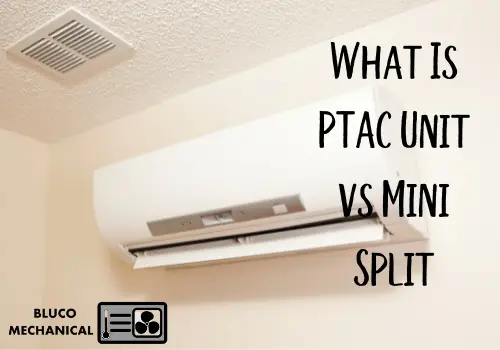What Is PTAC Unit vs Mini Split
Bluco Mechanical is an expert in ptac air conditioning repair in Brooklyn. Don’t get yourself in trouble when your Amana ptac is not heating just call at (929) 447-2077. We’re always here to sort out your all problems.
If you’re on the market for a new air conditioner, you’ve definitely come across two distinct types: packaged terminal air conditioners (PTACs) and ductless mini-splits.

Which of these are these? What are the distinctions between them, and which is the better option for you? That is the question addressed in this article. Continue reading to discover more about each of these air conditioning systems, the optimum times to use them, and how to choose the appropriate one for you.
What is a Packaged Terminal A/C?
A packaged terminal air conditioner, or PTAC, is a type of commercial air conditioner that is installed through a wall. You’ve undoubtedly seen them in a hotel room while on vacation. So, what are the primary advantages of a PTAC?
Increased Efficiency: PTACs have a terrible reputation for being energy guzzlers in the past. However, manufacturers have made significant strides in recent years, making PTACs an excellent alternative, particularly for hotels that must cool and heat several rooms.
Use Them All Year: Because they are meant for use in businesses, hotels, and senior living facilities, PTACs include a heating feature. This may be an electric coil or a heat pump, but in any case, you’ll have year-round comfort.
Simple to Install: When compared to other types of air conditioning, PTACs are comparatively simple to install. When replacing an existing unit, the new unit can normally be inserted into the existing hole. If this is your first time installing a PTAC, you will need to make a hole. Take an appointment with ptac repair near me.
But What Exactly is a Mini-Split?
Now that we understand what a PTAC is, what is a micro split? Mini-split air conditioners, also known as ductless split system air conditioners, are multi-component systems that deliver effective cooling and, in some cases, heating to particular rooms that lack existing ductwork. While the majority of models are intended for domestic usage, there are others that are suitable for business settings such as restaurants and offices. Among the several advantages of mini splits are the following:
- Mini-splits, like PTACs, do not require existing ductwork in a room to cool and heat it. Mini-splits are an excellent choice for new construction, home expansions, and sunrooms, among other applications.
- Zone Comfort: Mini split air conditioners cool, and in some models, heat, particular rooms or zones. While the majority of ductless systems are designed to give comfort in a single room, there are choices for usage in two or even three zones. This makes them ideal for residential use and restaurants, but not necessarily for large-scale hotels.
- Even More Efficiency: While PTACs have improved their efficiency over the years, they still fall short of mini splits in terms of efficiency. Mini-splits must meet at least a Seasonal Energy Efficiency Ratio (SEER) to be utilized in the United States, and many models go even farther by achieving an Energy Star certification.
Which Should I Choose Between a PTAC and a Mini-Split?
You’ve learned a little bit about both micro splits and PTACs thus far; now it’s time to make a choice. Which one is? the most appropriate for you? What is PTAC unit vs mini-split?
You should, in fact:
Select a PTAC if:
You’re looking for comfort in multiple rooms. PTACs are excellent solutions for cooling and heating in hotels, dorm rooms, and assisted living facilities, among other applications, because they can be installed in each room, allowing guests to choose their comfort.
Cost is an issue. On average, PTACs will be less expensive than micro splits. Installing enough micro splits to cool and heat a hotel will be significantly more expensive than installing many PTACs.
You require a low-maintenance solution for your comfort. PTACs are typically low-maintenance. When you own a business property, time is money, which is why it’s critical to have a unit that does not require continual downtime.
Replacement is critical. Because the majority of PTACs are 42 inches wide, replacing existing units is as simple as removing the old and sliding in the new.
If you’re considering a mini-split, consider the following:
- You are a property owner. Mini-splits are superior to PTACs for residential settings for a multitude of reasons, including efficiency and aesthetics, as mini-splits take up less wall space and blend better into rooms.
- Efficiency is a priority. Mini-splits will be more energy-efficient than PTACs. Numerous versions are energy star rated, and because they are zone-controlled, you may chill and heat only the rooms you specify.
- You care about noise. Unlike PTACs, which have all of their components in the room. Because the compressor of a micro split is located outside, the only noise you’ll hear indoors will be from the unit’s fan.
- You are unconcerned about expert installation. While there are some do-it-yourself mini splits available, the majority of models will require installation by a licensed HVAC specialist.



No Comments
Be the first to start a conversation